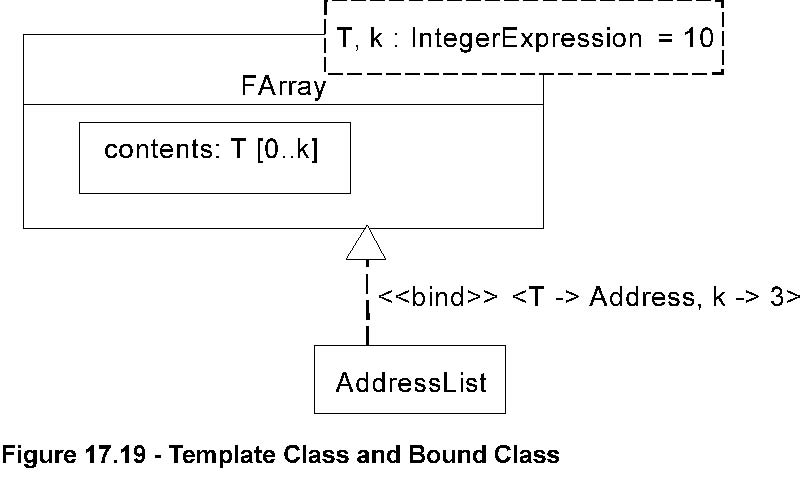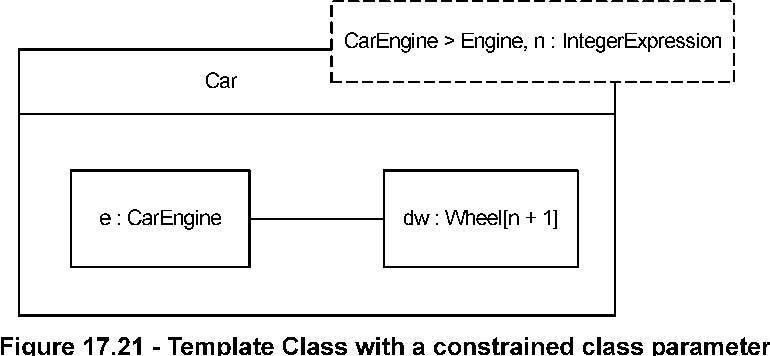*Attributes
No additional attributes
Associations
• ownedSignature : RedefinableTemplateSignature[0..1] The optional template signature specifying the formal template parameters.
Subsets Element::ownedElement.
Issue 9110 - rename ‘parameter’ to ‘templateParameter’ and adjust constraint
• templateParameter : ParameterableElement [0..1] The template parameter that exposes this element as a formal parameter.
Redefines ParameterableElement::templateParameter.
Constraints
No additional constraints
Additional Operations
[1] The query isTemplate() returns whether this templateable element is actually a template.
Classifier::isTemplate() : Boolean;
isTemplate = oclAsType(TemplatableElement).isTemplate() or general->exists(g | g.isTemplate())
Semantics
Classifier in general
Classifier provides the abstract mechanism that can be specialized to support subclass of Classifiers to be templates, exposing
subclasses of Classifier as formal template parameters, and as actual parameters in a binding of a template.
Classifier as a kind of templateable element provides the abstract mechanism that can be specialized by subclasses of Classifier
to support being defined as a template, or being bound to a template.
A bound classifier may have contents in addition to those of the template classifier. In this case the semantics are equivalent
to inserting an anonymous general classifier that contains the contents, and the bound classifier is defined to be a specialization
this anonymous general classifier. This supports the use of elements within the bound classifier as actual parameters in a
binding.
A bound classifier may have multiple bindings. In this case the semantics are equivalent to inserting an anonymous general
bound classifier for each binding, and specializing all these bound classifiers by this (formerly) bound classifier.
The formal template parameters for a classifier include all the formal template parameters of all the templates it specializes.
For this reason the classifier may reference elements that are exposed as template parameters of the specializes templates.
Collaboration
A Collaboration supports the ability to be defined as a template. A collaboration may be defined to be bound from template
collaboration(s).
Issue 8527 - remove last sentence of paragraph
A collaboration template will typically have the types of its parts as class template parameters. Consider the Collaboration
in Figure 9.11 on page 177. This Collaboration
can be bound from a Collaboration template of the form
found in Figure
17.23, by
means of the binding described in Figure 17.24.
A bound Collaboration is not the same as a CollaborationUse ; in fact, parameterized Collaborations (and binding) cannot
express what CollaborationUse s can. Consider the Sale Collaboration in Figure 9.13 on page 179. It is defined by
means of two parts (Buyer and Seller) representing roles in this collaboration. The two CollaborationUse s wholesale and retail
in Figure 9.14 on page 180 cannot be defined as bound Collaborations .
Issue 8527 - fix typos and some stylistic stuff
A bound Collaboration is a Collaboration, while a CollaborationUse is not. A CollaborationUse is defined by means of RoleBindings,
binding parts in a Collaboration (here Buyer and Seller) to parts in another classifier (here broker, producer, and consumer
in BrokeredSale) with the semantics that the interaction described in Sale will occur between broker, producer, and consumer.
Binding eventual Buyer and Seller part template parameters (of a Sale Collaboration template) to broker and producer would
just provide that the parts broker and producer are visible within the bound Sale Collaboration. Even if Sale had two part
template parameters Buyer and Seller, it could not use these for defining an
internal structure as is the case in Figure 9.14 on page 180. Parameters, by their very nature, represent elements that are
defined ‘outside’ a Collaboration template and can therefore not be parts of an internal structure of the Collaboration template.
Semantic Variation Points
If template parameter constraints apply, then the actual classifier is constrained as follows. If the classifier template
parameter:
•
has a generalization, then an actual classifier must have generalization with the same general classifier.
•
has a substitution, then an actual classifier must have a substitution with the same contract.
•
has neither a generalization nor a substitution, then an actual classifier can be any classifier.
If template parameter constraints do not apply, then an actual classifier can be any classifier.
Notation
See ClassifierTemplateParameter for a description of how a parameterable classifier is displayed as a formal template parameter.
See TemplateableElement for the general notation for displaying a template and a bound element.
When a bound classifier is used directly as the type of an attribute, then <classifier expression> acts as the type of the
attribute in the notation for an attribute:
[<visibility>] [‘/’] <name> [‘:’ <attr-type>] [‘[‘<multiplicity> ‘]’] [‘=’ <default>][‘{‘<attr-property> [‘,’<attr-property>]* ‘}’]
When a bound classifier is used directly as the type of a part, then <classifier-expression> acts as the classname of the
part in the notation for a part:
(([<name>] ‘:’ <classname>) | <name>) [‘[‘<multiplicity>’]’]
Presentation Options
Collaboration extends the presentation option for bound elements described under TemplateableElement so that the binding information
can be displayed in the internal structure compartment.
Examples
Class templates
As Classifier is an abstract class, the following example is an example of concrete subclass (Class) of Classifier being a
template.
The example shows a class template (named FArray) with two formal template parameters. The first formal template parameter
(named T) is an unconstrained class template parameter. The second formal template parameter (named k) is an integer expression
template parameter that has a default of 10. There is also a bound class (named AddressList) that substitutes the Address
for T and 3 for k.

The following figure shows an anonymous bound class that substitutes the Point class for T. Since there is no substitution
for k, the default (10) will be used.

Figure 17.20 - Anonymous Bound Class
The following figure shows a template class (named Car) with two formal template parameters. The first formal template parameter
(named CarEngine) is a class template parameter that is constrained to conform to the Engine class. The second formal template
parameter (named n) is an integer expression template parameter.

The following figure shows a bound class (named DieselCar) that binds CarEngine to DieselEngine and n to 2.
DieselCar : Car<CarEngine -> DieselEngine, n -> 2>
Figure 17.22 - Bound Class
Collaboration templates
The example below shows a collaboration template (named ObserverPattern) with two formal template parameters (named SubjectType
and ObserverType). Both formal template parameters are unconstrained class template parameters.

ObserverPattern

The following figure shows a bound collaboration (named Observer) that substitutes CallQueue for SubjectType, and SlidingBarIcon
for ObserverType.
Observer


ObserverPattern<SubjectType -> CallQueue, ObserverType -> SlidingBarIcon>


Figure 17.24 - Bound Collaboration